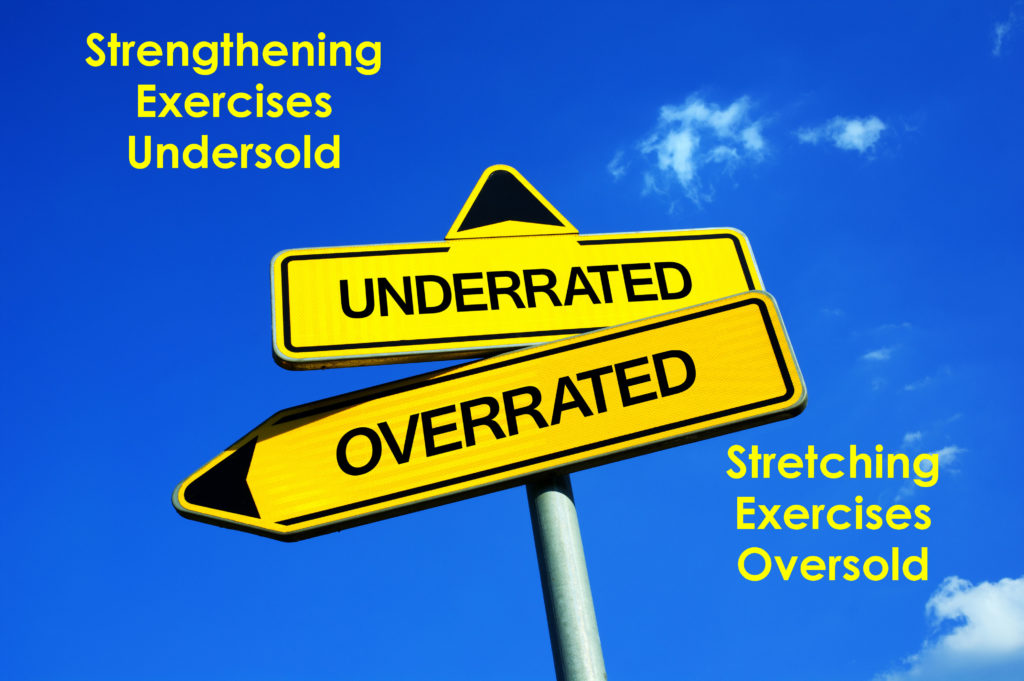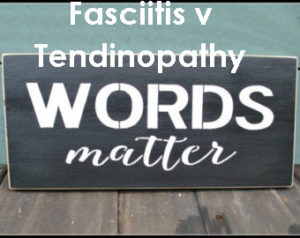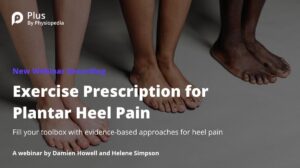Plantar fasciitis v tendinopathy words matter – stretching exercises are overrated

Why is the plantar region the only region of the body where the terminology of fasciitis is used? Fascial tissue is present throughout the body including the ankle, knee, hip, back, and abdominal regions of the body. Yet, we do not use the term knee fasciitis or back lumbar fasciitis.

We know that stretching exercises are a recommended treatment for plantar fasciitis.
How do we know that? Professional medical societies' guidelines for treatment report strong evidence that stretching exercises are an effective treatment in the management of plantar fasciitis.
But what is the rationale? How does stretching exercise help heal injured tissue?
Mechanotransduction supplies a theoretical basis for how various forms of exercise promote the healing of injured tissue. Mechanotransduction is how cells sense and respond to physical forces. The physical forces are tensile, compressive, and shear loading resulting in a cascade of metabolic molecular events at the cellular level.

The historical assumption is that plantar heel pain syndrome is an injury to the plantar fascia tissue that attaches to the heel bone. A common assumption is the plantar fascia tissue function is a passive windlass, like a rigid cable (Williams, L.R. - 2022). The assumption is that the plantar fascia is a passive structure that has led to a lack of active strengthening exercises as part of the treatment regimen.
Antithesis
A newer perspective is the recognition that the site of the pain/injury in plantar fasciitis is aponeurosis. Aponeurosis is a thin sheath of connective tissue (facia) that connects muscles to bones. Aponeurosis is not a passive tissue (Raiteri, B.J. 2018. Aponeuroses are like tendons. The plantar aponeurosis and tendons do not function as a passive rigid cable but likely have extensibility, elastic recoil, and positive energy force (Eng, C.M – 2018). Additionally at the site where the aponeurosis attaches to the heel bone 3-foot muscles tendons attach, abductor hallicus brevis, flexor digit mini, and quadratus plantea to the heel bone. Sean Christie and colleagues propose the terminology of plantar intrinsic muscle tendinopathy.
A better terminology for plantar fasciitis is plantar tendinopathy. This opens a whole new perspective on how to manage plantar heel pain syndrome.
Stretching exercises are oversold and overbought
My conjecture is there should be a similar outline of interventions whether the tendon problem is in the heel, ankle, knee, or shoulder.
An internet search query results in twice as many web pages for the keyword search plantar fasciitis stretching exercises versus the keyword search plantar fasciitis strengthening exercises. Whereas using the keyword search Achilles tendinopathy stretching exercises versus the keyword search Achilles tendinopathy strengthening exercises there are an equal number of web pages.
Clinical practice guidelines for plantar fasciitis strongly recommend the relatively passive interventions of stretching exercises, manual therapy, and the use of night splints. However, a closer look at the evidence raises the question are stretching exercises are oversold. The guidelines strongly recommend stretching exercises based on a review of controlled clinical trials. The clinical trials reviewed compare the effect of stretching exercises to other interventions, but do not compare to a group that did not use stretching exercises.
David Sweeting and colleagues report in a systematic review of the literature that there are too few studies to assess whether stretching is effective compared to not stretching or other interventions for either pain or function. This systematic review suggests stretching exercises are oversold
One study by Joel Radford and colleagues conducted a randomized controlled clinical trial comparing stretching exercises with fake therapeutic ultrasound treatment. The control group received only a fake therapeutic ultrasound treatment and no stretching exercises. Both the stretching group and the sham group got better. There was no difference in the magnitude of improvement between the two groups. The results suggest the sham group got better because of the natural course of healing and/or a placebo effect. This study suggests stretching exercises are oversold.
Jose Afonso and colleagues advance thoughtful questions about stretching. “To date, we feel that research has focused more strongly on answering what stretching can do, while more information is necessary as to how stretching compares to alternative interventions”?
In an opinion piece, James Nuzzo makes an elegant argument for de-emphasizing stretching exercises to ensure stretching does not negatively impact other exercises and does not take away from time allocation to exercises that have a more robust effect.
Plantar heel pain can be related to too much movement, in which case stretching exercises is contraindicated.
Stretching may not always be a solution.
Strengthening exercise is undersold & underbought

Returning to the guidelines for plantar fasciitis, strengthening exercises are not included in the recommendations. Whereas guidelines for Achilles tendinopathy weakly recommend stretching exercises and strongly recommend strengthening exercises. A mainstay of intervention for tendinopathies such as Achilles, patellar tendon, hip tendons, shoulder tendon, and elbow tendon is applying principles of mechanotransduction using progressive strengthening exercises. Yet, strengthening exercises are under-utilized for plantar heel pain.
Rathleff and colleagues postulate that stretching and strengthening exercises provide mechanical strain to injured tissue stimulating healing. Measurement of the strain is the change in the length of the tissue divided by the total length of the tissue. The strain of the aponeurosis or foot tendons is the change in length or deformation of tissue that results from the applied force. The strain of the aponeurosis and tendons occurs with passive stretching exercises and/or contraction of the muscle-tendon unit that occurs with progressive strengthening exercises (Merry, K – 2022).
Rathleff and colleagues postulate the magnitude of strain necessary to promote optimal healing of injured tissue needs to match or exceed the magnitude of strain that occurs during daily activities. The magnitude of strain that occurs using your hands to passively stretch and massage the plantar aponeurosis and tendons or using a night splint is small significantly less than the magnitude the tissue is subjected to in daily activities.
Isometric strengthening exercises are often the first step in a progressive strengthening program.
Melinda Smith and colleagues at The University of Queensland Australia share a well-developed and comprehensive strengthening exercise program for treating plantar heel pain.
Romain Tourillon shares a forward-thinking and aggressive strengthening exercise program for foot muscles.
Reduce emphasis on stretching exercises and increase emphasis on strengthening exercises
In mechanotransduction theory, the mechanical strain on the tissue stimulates healing. The injured tissue does not know whether the exercise is a stretching or strengthening exercise. The tissue does know when the mechanical strain is at an optimal level, not too weak not too strong. Comparing standard interventions for tendinopathy at other regions of the body that strongly recommend progressive strengthening exercises should not a similar approach be in use for plantar heel pain tendinopathy.
Words matter, recognize plantar heel pain syndrome is an injury to the aponeurosis and tendon, not a passive fascia tissue. Apply less time and resources using passive stretching exercises and allocating more time and resources to performing strengthening exercises, functional training, gait training, and aerobic exercise to decrease major contributing factors of high body mass index.
Treatment for plantar heel pain syndrome of stretching exercises is oversold and strengthening exercises are undersold.
A on demand-video webinar exploring this topic is available at Plus by Physiopedia entitled “Exercise Prescription for Plantar Heel Pain Webinar”
Use this code – “Damien25” for a 30% discount to access this webinar as well as the more than 500 continuing education webinar courses available at Plus by Physiopedia. This is the link http://bit.ly/DAMIEN30 with the 30% discount code embedded.
The information on this website is not intended or implied to be a substitute for professional medical advice, diagnosis, or treatment. You are encouraged to perform additional research regarding any information contained available through this website with other sources and consult with your physician.
Damien Howell Physical Therapy – 804-647-9499 – Fax: 866-879-8591 At-Home, At Office, At Fitness Facility – I come to you, I do home visits Damien@damienhowellpt.com

